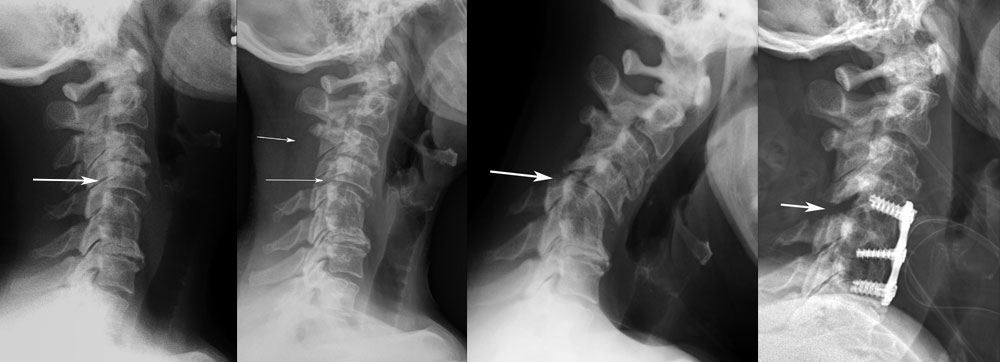Iatrogenic Instability of the Cervical Spine Overview
This is an example of what can happen when the spine becomes unstable after a simple laminectomy in the cervical spine. When normal, the cervical spine sits in a backwards curve called a lordosis. This curve allows gravity to “push” the vertebra backwards to align each vertebra properly. As the discs degenerate as these structures will to some degree in all of us, this curve can be lost and the spine “falls forward”.
This falling forwards puts pressure on the facets (the joints in the back of the spine) and can lead to a degenerative spondylolisthesis. This is a condition where the facets in the back of the neck wear out and allow the vertebra above to slip forward on the vertebra below. This slip can then create narrowing of the spinal canal called central stenosis. Of course, spinal canal narrowing can then lead to compression of the spinal cord and spinal cord dysfunction (called myelopathy).
In the example of this patient (who already had a fusion of the level below), she did develop a degenerative spondylolisthesis as noted in the first picture to the left (arrow points to the beginning of a slip). She did indeed also develop spinal cord compression and myelopathy. The surgeon decided to perform a laminectomy to open the canal and decompress the cord.
The second picture from the left has two arrows. The upper arrow points to the laminectomy (look at the missing spinous processes when compared to the first picture). The lower arrow points to the slip of C4 on C5 which is greater than the original slip. At this point, great care needs to be implemented to make sure the slip does not progress. Suggestion of an anterior fusion (ACDF) should be considered at this point.
Are you suffering from symptoms of Iatrogenic Instability?
Would you like to consult with Dr. Corenman about your condition?
You can set up a long distance consultation to discuss your
current X-rays and/or MRIs for a clinical case review.
(Please keep reading below for more information on this condition.)
Unfortunately, the slip did progress (see the third from the left picture-arrow) and the C5 nerves became involved. The nerves became stretched due to the displacement of the vertebra and the patient could not lift up her arms due to the loss of the deltoid muscle function. In addition, the spinal cord became stretched over the slipped vertebra/displacement of the C4 on the C5 vertebra creating more myelopathy symptoms.
As the C4 vertebra slipped further forward, the patient could not hold her head up due to this vertebral misalignment. Generalized neck pain occurred which was disabling.
To fix the slip, she was placed in traction (weights attached to her head) and this lasted for two days. The traction pulled her neck back to a somewhat normal alignment. An ACDF surgery was then completed where the vertebra was able to be fully realigned with the lower neck (see far right picture with the graft and plate- the arrow points to the facet gap which occurred when the facets became severely degenerative and eroded away). An autograft and plate were placed to hold the alignment and allow fusion. She had less cord compression symptoms immediately after the traction was placed and may get some deltoid function back.
For additional resources on iatrogenic instability of the cervical spine, please contact the office of Dr. Donald Corenman, spine specialist and neck doctor offering diagnostic and surgical second opinions to patients in the USA and around the world.
Related Content
- Chronic Radiculopathy
- Cervical Degenerative Disc Disease
- Cervical Degenerative Facet Disease
- Cervical Spine Instability
- Cervical Spine Fractures and Dislocations
- Failed Artificial Cervical Disc Replacement
- Failed Neck Surgery Syndrome
- Cervical Herniated Disc
- Arthritis of the Neck and Back
- Cervical Deformity
- Cervical Degenerative Kyphosis
- Cervical Degenerative Spondylolisthesis
- Cervical Central Stenosis & Myelopathy

